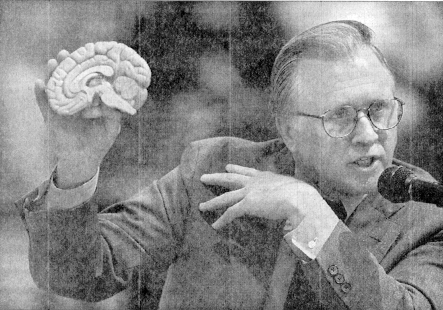|
|
The Des Moines Register, Wednesday, April 15, 1998, Page 3M
Ex-user, agents tell of meth's peril
By SHIRLEY SALEMY
REGISTER STAFF WRITER
 |
"My drug use was a secret to most
people, and I looked like a normal teen-ager, no different than any one of your sons or
daughters, students or friends."
-- Jaime Wood
17, of Blairstown.
Her father, Ronnie Wood, of Moulton offered his support at the hearing. |
Marion, Ia. - Her testimony was
first - and perhaps the most poignant - among a group of methamphetamine experts.
"When my use of crank got really bad, I gave up everything I could
to get my hands on the drug," Jaime Wood, 17, of Blairstown said Tuesday at a hearing
convened by U.S. Sen. Charles Grassley of Iowa. "I gave up money, my home, my
family, my personal possessions and my self-respect."
With her mother by her side, Wood described how her relationship with
her family fell apart. She stole from them and lied to them. She even began
manufacturing the drug to support her habit.
But her family stuck by her. Sober now for five months - with
plans for college - she gave advice to parents dealing with drug-addicted children:
"Oh, gosh," she said, "don't give up on them."
And if parents suspect their children are addicted? "Get in
the middle if you can," she said. "Do anything you can to get them away
from the friends they're with. It's probably the hardest thing to do."
Grassley, a Republican, scheduled the hearing as chairman of the Senate
Caucus on International Narcotics Control. It was a tour de force on meth, a highly
addictive drug to which the brain becomes a slave, according to Dr. Michael Abrams of
Broadlawns Medical Center in Des Moines.
Teen-agers listened to parts of the three-hour hearing, held in the gym
at Linn-Mar Junior High School.
Documenting how drugs are not only a metro problem but a rural one and
rallying more people to become concerned about the effects of meth were among the
hearing's goals.
Another goal was to establish that the drug is being smuggled in from
Mexico, a point that is not acknowledged by the Mexican government, Grassley said.
The resident agent-in-charge of the U.S. Customs Service in San Ysidro,
Calif., said trafficking occurs along well-established routes of marijuana, cocaine and
heroin.
Robert Tine brought a tire rim with a compartment in which smugglers
had hidden meth before welding it shut.
But Tine said agents face a dual threat. Not only is meth being
smuggled into the country but chemicals used to make it are also being smuggled into
Mexico from the United States.
Richard LaMere of the Drug Enforcement Administration in Cedar Rapids
said Mexican traffickers' dominance of the market is largely explained by the fact that
Mexican organized crime has access to large quantities of ephedrine on the international
market and regularly produces "unprecedented" quantities of high-purity meth in
"superlabs" in Mexico and California.
Ken Carter, director of the Iowa Division of Narcotics Enforcement,
said authorities are having an impact on some major trafficking organizations. But,
he said, they are hampered by the extent of the meth problem and limited resources -
personnel and overtime costs.
"Without significant increases in resources and support, the DNE
will be unable to disrupt the flow of methamphetamine into Iowa and reduce the negative
impact methamphetamine trafficking is having on the citizens of Iowa," he said.
Wood's mother also gave suggestions to parents, telling them to stay
involved with their children. "Know their friends, know what they're doing,
know where they're at," Debbie Wood said. "Don't give up on them.
Hang in there."

Dr. Michael Abrams of Broadlawns Medical Center
in Des Moines
uses a model to explain meth's effects on the brain Tuesday during a
hearing on narcotics control in Marion.
Reporter Shirley Salemy can be
reached at salemys@news.dmreg.com
or (515) 284-8131.
The Des Moines Register
Wednesday, April 15, 1998, Page 3M
letters@news.dmreg.com
|

